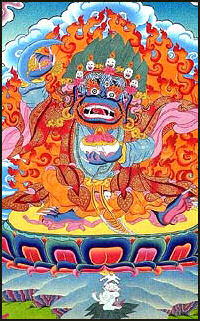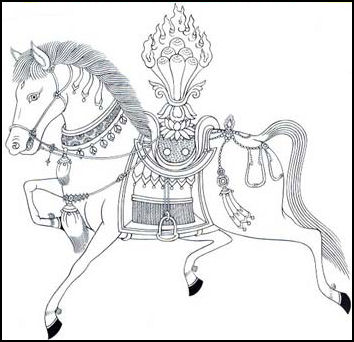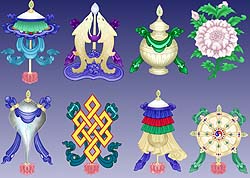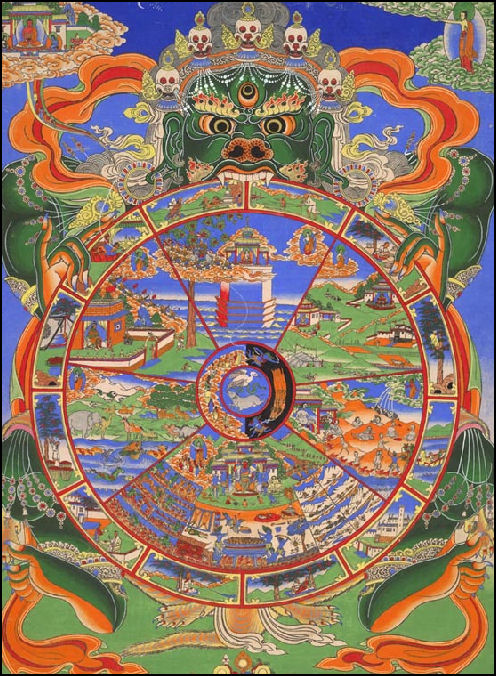TIBETAN BUDDHIST SYMBOLS

Mahakala Symbols from Tibetan Buddhism include: 1) the white elephant, an auspicious symbol associated with royalty and wealth; 2) the precious jewel, also known as “ju-I” ("as your desire"), representing wealth sufficient enough to satisfy a man's needs and desires. 3) Swastikas that point clockwise are Buddhist; those that point counter-clockwise are Bon. Tibetans consider the peacock to be an auspicious bird. The movement of its tail is associated with the way men tie their robes around their waists Tibetan dance movements have names such as “The peacocks wingspread” and “the drinking peacock.”
The Four Harmonious Brothers are often found painted on the walls of entrances to monasteries. Symbolizing harmony with nature, they are comprised of a bird on top of rabbit which is on top of a monkey on an elephant. The sun and moon and ying-and-yang-like motifs are painted on houses. They symbolize the complementary opposites: wisdom and compassion.
The wind horse (“longa”) is the main symbol found on prayer flags. It is famed for its ability to run like the wind. On his back he carries the Three Jewels of Buddhism — the Buddha, dharma, and sangha. The Kalachakra seal is likened with Kalachakra meditation deity and is also associated with the Dalai Lama. The queen, the minister and the general are common symbols that are indispensable aids to the king.
The most auspicious number to Tibetan Buddhists is 108. It is the number of books in the Tibetan Buddhist scripture, the number of beads in prayer necklace and the number of braids in a woman's traditional hair do. Praying 108 times is regarded as particularly meritorious because it “disturbs passions” of “mankind’s delusions” cited in Buddhist scripture. The number 108 is auspicious because it is a product of 9 x 4 x 3, with 9, 4 and 3 being auspicious numbers.
Ladders are painted on rocks around many monasteries, bridges and other places to symbolize the descent of Buddha Sakyamuni from the heaven back to the earth. It is said that the Buddha left for heaven at the age of 41, having ascended to the Heaven of Thirty-Three (Trayastrimsa) in order to give teachings to benefit the gods in the desire realms and to repay the kindness of his mother by liberating her from Samsara. He was exhorted by his follower and representative Maugalyayana to return, and after a long debate managed to return. This is considered to be one of the eight great deeds of the Buddha. He returned to earth by a special triple ladder prepared by Viswakarma, the god of machines.
See Separate Articles:TIBETAN BUDDHISM factsanddetails.com; TIBETAN BUDDHIST BELIEFS: KALACHAKRA, SHAMBALA, TANTRISM AND ORACLES factsanddetails.com; TIBETAN ART factsanddetails.com; TANTRISM factsanddetails.com; TIBETAN BUDDHIST TEXTS factsanddetails.com; TIBETAN BUDDHIST GODS, BODHISATTVAS AND BUDDHAS factsanddetails.com; BODHISATTVAS factsanddetails.com
RECOMMENDED BOOKS:“The Encyclopedia of Tibetan Symbols and Motifs” by Robert Beer Amazon.com; “The Handbook of Tibetan Buddhist Symbols” by Robert Beer Amazon.com; “Buddhist Symbols in Tibetan Culture : An Investigation of the Nine Best-Known Groups of Symbols” by Dagyab Rinpoche and Robert A. F. Thurman Amazon.com; Tibetan Buddhism: “Essential Tibetan Buddhism” by Robert A. F. Thurman Amazon.com; “Initiations and Initiates in Tibet” by Alexandra David-Neel Amazon.com; “The Secret Oral Teachings in Tibetan Buddhist Sects” by Alexandra David-Neel, Lama Yongden Amazon.com; Introduction to Tibetan Buddhism by John Powers Amazon.com; “The World of Tibetan Buddhism: An Overview of Its Philosophy and Practice” by His Holiness the Dalai Lama, Geshe Thupten Jinpa Amazon.com; “Tibetan Buddhism: With its Mystic Cults, Symbolism and Mythology, and in Its Relation to Indian Buddhism” by L Austine Waddell Amazon.com; “The Jewel Tree of Tibet: The Enlightenment of Tibetan Buddhism” by Robert Thurman and Sounds True Amazon.com; “A Concise Introduction to Tibetan Buddhism” by John Powers Amazon.com; “The Preliminary Practices of Tibetan Buddhism” by Geshe Rapten Amazon.com; “Teachings and Practice of Tibetan Tantra” Amazon.com; “Tantra in Practice” by David Gordon White Amazon.com
Importance of Symbols in Tibetan Buddhism

Wind horse
Describing pilgrims at the Dalai Lama’s house, John Power wrote: All along the path are religious symbols, most of which are connected with Avalokitesvara or his human manifestation, the Dalai Lama. There are several "mani walls," which are piles of stones, each of which is inscribed with the mantra om mani padme hum. This literally means, "om jewel in the lotus hum," and it has tremendous significance for devout Tibetan Buddhists. The syllable om is commonly found in mantras and is said to symbolize the ultimate nature of all reality, the final truth of things. The "jewel in the lotus" is compassion, the quality that Avalokitesvara is thought to embody. [Source: John Power, “Bon: A Heterodox System”, From Chapter 16 of “Introduction to Tibetan Buddhism”, Snow Lion Publications, 1995. Powers is an American born Professor of Asian Studies and Buddhism who much of his teaching career at the Australian National University in Canberra.]
The symbolism of this mantra reveals a great deal about the presuppositions and practices of Tibetan Buddhism. A lotus is born in the muck and mud at the bottom of a swamp, but when it emerges on the surfice of the water and opens its petals a beautiful flower appears, unstained by the mud from which it arose. Similarly, genuine compassion arises from the muck of the ordinary world, which is characterized by fighting, hatred, distrust, anxiety, and other negative emotions. These emotions tend to cause people to become self-centered and lead to suffering and negative actions. But just as the world is the locus of negative emotions, it is also the place in which we can become buddhas, enlightened beings who have awakened from the sleep of ignorance and who perceive reality as it is, with absolute clarity and with profound compassion for suffering living beings.
Just as the lotus arises from the mud of the swamp, so buddhas were formarly human beings, immersed in the negative thoughts and actions in which all ordinary beings engage: the strife, wars, petty jealousies, and hatreds to which all ordinary beings are subject. Through their meditative training, however, buddhas have transcended such things, and like lotuses have risen above their murky origins and look down on them unsullied by the mud and mire below. The symbolism may be extended still further, because buddhas do not simply escape the world and look down on others with pity or detached amusement; rather, like the lotus, which has roots that still connect it with the mud at the bottom of the lake, buddhas continue to act in the world for the benefit of others, continually taking human form in order to help them, to make them aware of the reality of their situations, and to indicate the path to the enlightenment of buddhahood, which can free them from all suffering.
All of these symbols are operating in the minds of the Tibetans who are making the circuit around the residence of the Dalai Lama. They perceive him as the embodiment of their own highest aspirations, a person who through individual effort, compassionate activity, and diligent meditation has transcended the world, but who still continues to emanate physical manifestations for the benefit of others. The compassion of Avalokitegvara is completely unstained by any ordinary emotions; he has no need for praise, does not seek the approval of others, and his actions are completely untouched by thoughts of personal gain. Rather, he embodies the highest and purest level of compassion, a compassion that is said to be inconceivable to ordinary beings. The development of such pure compassion in the ordinary world of ignorance, desire, and hatred is said to be as rare as a lotus growing up from the bottom of a swamp and opening its petals to reveal a perfect jewel in the middle. This indicates the multi-faceted nature of the symbolism of the mantra that Tibetans chant as they circumambulate the residence of the Dalai Lama. As they walk, they try to keep this symbolism in mind, because it is thought that the more one familiarizes oneself with something, the more natural it becomes, and one comes more and more to think and act accordingly.
Eight Auspicious Symbols of Tibetan Buddhism

Eight Auspicious Symbols
The Eight Auspicious Symbols are associated with gifts made to Buddha upon his enlightenment. The first four are: 1) the Precious Parasol (symbolizing protective powers of the Buddhist doctrine, it is usually placed over Buddha images to protect them from evil spirits); 2) the White Conch Shell (symbolizing the propagation of the Buddhist doctrine, blown to signal prayer time and celebrate the Buddha’s enlightenment and the potential of all humans for enlightenment); 3) the Golden Fishes (representing abundance, felicity and liberation from the Wheel of Life); and 4) the Lotus Flower (symbolizing purity and compassion of Buddha because it is a beautiful thing that rises from muddy waters); 5) the Banner of Victory (marking the victory of Buddhist wisdom over ignorance and the expulsion of all worries); 6) the Knot of Eternity (representing the eternal, intertwined passage of time, harmony, love and unity); 7) the Vase of Great Treasures (containing the jewels of enlightenment, the water of eternity and votive offerings to the deities); and 8) the Wheel of Law (representing the Eightfold Path to salvation and the movement of Buddhist laws). Also known as the Wheel of Dharma, the Wheel of Law turns 12 times, three times for each of the Four Noble Truths.
Groupings of eight auspicious symbols were originally used in India at ceremonies such as an investiture or coronation of a king. An early grouping of symbols included: a throne, a swastika, a handprint, a hooked knot, a vase of jewels, a water libation flask, a pair of fishes, and a lidded bowl. In Myanmar Buddhism, the eight symbols represent good fortune and signify the offerings made by the gods to Shakyamuni Buddha immediately after he gained enlightenment. [Source: chinaculture.org, Chinadaily.com.cn, Ministry of Culture, P.R.China, October 17, 2005]
The Parasol (gdugs) was a traditional Indian symbol of protection and royalty. The parasol denoted wealth and status — the more included in a person's entourage, the more influential the person was, with 13 parasols defining the status of king. Symbolically, the protection provided by the parasol is from the heat of suffering, desire, obstacles, illness, and harmful forces. In Buddhist mythology, the king of the nagas (serpent-like creatures) gave a jeweled umbrella to the Buddha. A typical Tibetan parasol consists of a thin round wooden frame with 8, 16, or 32 thinly arched wooden spokes. Through its center passes a long wooden axle-pole embellished at the top with a metal lotus, a vase, and the triple jewel. White, yellow, or multicolored silk stretches over the domed frame and a folded or pleated silk skirt with 8 or 16 hanging silk pendants attached hang from the circular frame. The parasol dome represents wisdom and the hanging skirt, compassion.
Conch Shell (dun) has traditionally been used in Buddhist worship as a trumpet or offertory vessel and symbolizes the spoken word of Buddha. The conch is thought to have served as a horn-trumpet in ancient Indian. Epics from that time have heroes carrying conch shells. The Indian god Vishnu has a conch shell as one of his symbols. The conch shell is an emblem of power, authority, and sovereignty; its blast is believed to banish evil spirits, avert natural disasters, and scare away poisonous creatures. Shells that spiral to the right are very rare and considered especially sacred.
The Golden Fishes (gser-na) originally represented the two main sacred rivers of India — the Ganges and the Yamuna. In Buddhism, the fish symbolize happiness as they have complete freedom of movement in the water. They represent fertility and abundance.
Lotus flower (padma) symbolizes purity, renunciation, and divinity. It rise from muddy roots and Nirvana arises from world of suffering.
Banner of Victory (dpal-be) symbolizes victory over ignorance and death. Banners were traditionally carried in battle. Great warriors would often had banners with their own emblems, the banners being carried on the back of their chariots. Krishna had a banner bearing the Garuda (a bird deity). In early Buddhism, the banner represented Buddha's victorious enlightenment with his overcoming the armies of Mara (hindrances and defilements). Legend says the banner was placed on the summit of Mt Meru, symbolizing Buddha's victory over the entire universe. In Tibetan Buddhism, the banner represents eleven methods of overcoming Mara: the development of knowledge, wisdom, compassion, meditation, and ethical vows; taking refuge in the Buddha; abandoning false views; generating spiritual aspiration, skilful means, and selflessness; and the unity of the three samádhis of emptiness, formlessness, and desire-less-ness.
Endless Knot (apal-be) symbolizes devotion. It was originally associated with Vishnu and symbolized his devotion to his consort Lakshmi, the goddess of wealth and good fortune. It represents the Buddha's endless wisdom and compassion. It also can represent continuity or dependent origination as the underlying basis of life.
The Vase (bum-pa) is known as "the vase of inexhaustible treasures" — however much is removed from it, the vase remains perpetually full. Vases have traditionally been used as the storage urn of a sacred receptacle and thus symbolizes hidden treasures. In Tibet vases sealed with precious and sacred substances are commonly placed upon altars and on mountain passes, or buried in water springs. Images of the vase are often highly ornate with a flaming jewel or jewels protruding from its mouth.
Tibetan Buddhist Wheel of Life
The walls or entrances of Buddhist monasteries and pagodas are often decorated with "Wheels of Life," paintings representing principals of Buddhism — the Dharma, the cosmos and the concept of karma. . They are complex, image-filled paintings that aim to show viewers how desire imprisons us in a world of suffering and rebirth and that the mind is only a delusion. The hub of the wheel symbolizes moral discipline and the Buddha’s teachings which set the wheel of dharma in motion. The eight spokes represent analytical insight via rim-meditative concentration. The eight spokes point to the eight directions and symbolize the Buddha's Noble Eightfold Path: right understanding, right thought, right speech, right action, right livelihood, right effort, mindfulness, and concentration.
The wheel is an ancient Indian symbol of creation, sovereignty, protection, and the sun. The six-spoke wheel was associated with Vishnu and was know as the Sudarshana Chakra. Pictured on flag of India and associated with the Buddhist India king Ashoka, The wheel represents motion, continuity, and change, forever moving onwards like the circular wheel of the heavens. Buddhism adopted the wheel as a symbol of the Buddha's teachings and his first discourse at the Deer Park in Sarnath is known as "the first turning of the wheel of dharma." In Tibetan Buddhism, it is understood as "the wheel of transformation" or spiritual change. The wheel of law or the wheel of Dharma represents Dharma, the cosmos and the concept of karma. The central wheel is symbolic of Buddha’s teachings which set the wheel of dharma in motion. [Source: chinaculture.org, Chinadaily.com.cn, Ministry of Culture, P.R.China, October 17, 2005]
The three cardinal sins — passion and delusion (represented by a cock), hatred (a snake), and greed and stupidity (a pig) — are often situated at the center of the wheel. The wheel is turned by Yama, the Lord of Death, who represents the limitations of existence. At the bottom of the wheel are hot and cold hells and a scale used to measure good and bad karma one has accumulated in one’s lifetime. In the ring outside the center are the 8 or 12 karma formations, which contain the victims of bad karma (black background) on the left and the beneficiaries of good karma (white background) on the right. In the next ring are the six spheres of existence; then the twelve links in the chain of causation, culminating in the search for truth; and finally in the outer most ring are symbols depicting impermanence or death.
The six spheres of existence are; 1) the realm of the gods, a transitory place where happiness rises above suffering; 2) the realm of the asuras (jealous gods), where creatures of all sorts fight over fruit on the wishing tree and have to be reminded by Buddha to stay on the path; 3) the realm of the pretas (the hungry ghosts), the home of grotesque figures who have given into greed and can’t eat because their throats are too narrow; 4) the hells, where creatures with cold hearts and anger live in misery; 5) the realm of the animals, a place of ignorance, lethargy and apathy; and 6) the realm of the humans, characterized by birth, old age, disease, sickness and death.
The twelve links in the chain of causation features: 1) a blind woman (symbolizing ignorance); 2) a potter (unconscious of will); 3) a monkey (consciousness); 4) men in a boat (self-consciousness); 5) house (the five senses); 6) lovers (attachment); 7) a man with an arrow in his eye (feeling); 9) people drinking (desire); 10) a figure grasping fruit from a tree (greed); 11) pregnancy (birth); and 12) a man with a corpse (death).

Wheel of life
Animal Symbols in Tibetan Buddhism
The Four Dignities refers to four animals with important symbolic meaning in Tibetan Buddhism: 1) the Garuda, 2) the Sky Dragon, 3) the Snow Lion and 4) the Tiger. They are often seen in the corners of Tibetan prayer flags, accompanying the Wind Horse. They represent the qualities and attitudes necessarily developed on the spiritual path to enlightenment. These are qualities such as awareness, vast vision, confidence, joy, humility and power.
The garuda and the dragon have their origin in Indian and Chinese mythology, respectively. However, regarding the origin of the animals as a tetrad, "neither written nor oral explanations exist anywhere" with the exception of a thirteenth-century manuscript called "The Appearance of the Little Black-Headed Man" (dBu nag mi'u dra chag), and in that case a yak is substituted for the snow lion, which had not yet emerged as the national symbol of Tibet. In the text, a nyen (mountain spirit) kills his son-in-law, Khri-to, who is the primeval human man, in a misguided attempt to avenge his daughter. The nyen then is made to see his mistake by a mediator and compensates Khri-to's six sons with the gift of the tiger, yak, garuda, dragon, goat, and dog. The first four brothers then launch an exhibition to kill robbers who were also involved with their mother's death, and each of their four animals then becomes a personal drala ("protective warrior spirit") to one of the four brothers. The brothers who received the goat and dog choose not to participate, and their animals therefore do not become drala. Each of the brothers represents one of the six primitive Tibetan clans (bod mi'u gdung drug), with which their respective animals also become associated. [Source: Wikipedia +]
The four animals (with the snow lion replacing the yak) also recur frequently in the Epic of King Gesar and sometimes Gesar and his horse are depicted with the dignities in place of the windhorse. In this context the snow lion, garuda and dragon represent the Ling community from which Gesar comes, while the tiger represents the family of the Tagrong Gesar's paternal uncle.
Meanings of Colors in Tibetan Buddhism
All of the colors used in Tibetan art and its rituals holds specific meanings. There are five main colors that are known as pancha-varna in Sanskrit, which means The Five Pure Lights. Each color represents a state of mind, a celestial Buddha, a body part, a part of the mantra word Hum or a natural element. It is believed that by meditating on the individual colors, which contain their respective essences and are associated with a particular buddha or bodhisattva, spiritual transformations can be achieved. [Source: Chloe Xin, Tibetravel.org]
Blue is associated space are represents purity and healing. Akshobhya is the Buddha of this color. Ears are the body part that is represented by the color blue. Air is the element that accompanies this color. It is believed, when meditating on this color, anger can be transformed into wisdom.
White is associated with air and is the color of learning and knowledge in Buddhism. It is represented by the Buddha Vairocana. The eyes are associated with white. White is in the elemental group water. If meditated upon, white can cut the delusion of ignorance and turn it into the wisdom of reality.
Red is associated with fire and is related to life force and preservation. The Buddha Amitabha is depicted with a red body in Tibetan art. The part of the body associated with this color is the tongue. Fire is the natural element complementary to the color red. In Buddhism, meditating on the color red transforms the delusion of attachment into the wisdom of discernment.
Green is associated with water and is the color of balance and harmony. Amoghasiddhi is the Buddha of the color green. The head is the body part that is associated with this color. Green represents nature. Meditate on this color to transform jealousy into the wisdom of accomplishment. Yellow is associated with with earth and symbolizes rootedness and renunciation. Buddha Ratnasambhava is associated with yellow. The nose is represented by this color. Earth is the element that accompanies the color yellow. Yellow transforms pride into wisdom of sameness when visualized in meditation.
The Five Pure Lights are often seen in Mandala and Tibetan Buddhist prayer flags which you can see everywhere if you make a tour to Tibet. The colors may vary, but there is always a set of five. In addition to this, there is the Buddhist concept of the "rainbow body. The rainbow body is a concept in Tibetan Buddhism when everything begins to transform into pure light. It is said to be the highest state attainable in the realm of samsara before the "clear light" of Nirvana. As the spectrum contains within itself all possible manifestations of light, and thus of color, the rainbow body signifies the awakening of the inner self to the complete reservoir of terrestrial knowledge that it is possible to access before stepping over the threshold to the state of Nirvana. Understandably, when depicted in the visual arts, due to the profusion of colors, the result is spectacularly unique.
Image Sources: Kalachakranet.org and Simha.com except Texts, Wason collection, and Wheel of Life, Library of Congress.
Text Sources: 1) “Encyclopedia of World Cultures: Russia and Eurasia/ China”, edited by Paul Friedrich and Norma Diamond (C.K.Hall & Company, 1994); 2) Liu Jun, Museum of Nationalities, Central University for Nationalities, Science of China, China virtual museums, Computer Network Information Center of Chinese Academy of Sciences, kepu.net.cn ~; 3) Ethnic China ethnic-china.com *\; 4)\=/; 5) China.org, the Chinese government news site china.org | New York Times, Washington Post, Los Angeles Times, Times of London, Lonely Planet Guides, Library of Congress, Chinese government, Compton’s Encyclopedia, The Guardian, National Geographic, Smithsonian magazine, The New Yorker, Time, Newsweek, Reuters, AP, AFP, Wall Street Journal, The Atlantic Monthly, The Economist, Foreign Policy, Wikipedia, BBC, CNN, and various books, websites and other publications.
Last updated September 2022
